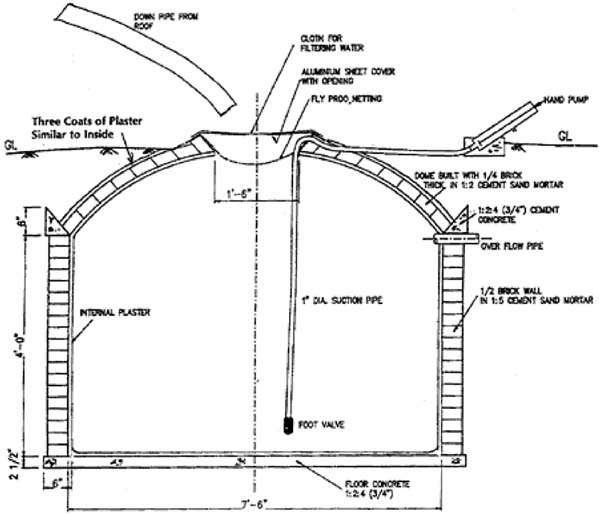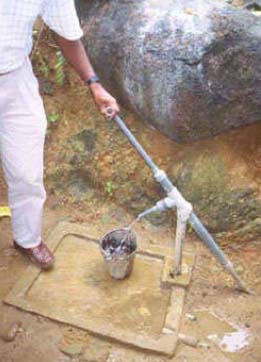How to Build an Underground Brick Dome Water Tank
Inhaltsverzeichnis
Übersicht
Übersicht übernommener Howtopedia Artikel, Zum Übersetzten Artikel , zum originale Artikel
Short Description
- Problem: to preserve and use water efficiently
- Idea: building an underground brick dome water tank
- Difficulty: Difficult
- Price Range: Rps. 6,500 (UK£100)
- Material Needeed: bricks, water handpump, concrete, wooden sticks, iron rod
- Geographic Area: Global
- Competencies:
- How Many people? Up to 5 Persons
- How Long does it take?
The Underground Brick Dome Tank (5m3), Sri Lanka - A Case Study - Technical Brief
Technology challenging poverty
This is RWH system, developed by the CWSSP programme in Sri Lanka. The tank, a 5m3 underground brick built tank, is based loosely on the design of the Chinese below ground biogas tank. Indeed, the Sri Lankan engineer who designed the system had studied for some years in China. This is a good example of cross fertilization of technologies across cultures, as well as the application of appropriate technology.
Again, this system was introduced due to the difficulties faced in bringing water to this community in a conventional manner. There was a lot of opposition to the RWH technology in the area at first, as it was a technology that was not widely known in the area. Now, after 2 years using the rainwater falling on her roof, Mrs. Emsayakar, of Batalahena Village near the town Matara, sees things very differently.
The alternative offered by CWSSP was a handpump per 10 households. This still means walking to collect water. Mrs. Emsayakar joked that they can still use the handpump of their neighbours when they wish. She has not, however, had to do so yet as the harvested water meet all the needs of the family of 5, as long as they conserve water carefully. She also said, however, that she would prefer a piped/pumped supply which would mean that they could use as much water as they wish.
Technical detail
The tank is a 5m3 below ground cylindrical brick construction based on the design of a Chinese biogas digester (see Figure 1 below). It has a diameter of 2.5m and a height of 1.3m to the base of the cover. The cover is a constructed using a clever brick dome design which can be left open to provide access. Water extraction is either by bucket, by handpump or by gravity through a pipe/tap arrangement where the topography and ground conditions are suitable. The cost of the tank is in the region of Rps.6,500 (UK£100). The construction details given to local masons are given below.
The Sri Lanka Brick Dome Tank - Construction details
- Find suitable site
- Dig pit 0.5m larger than the tank diameter
- Plant an iron rod in the centre of the pit, making sure it is vertical.
- Construct concrete base.
- Start constructing walls using wire from iron rod to maintain the radius.
- Once walls are complete backfill the gap between wall and pit with sand.
- Make concrete ring beam to the shape shown. No reinforcing is required. Fit overflow pipe at this point if required.
- Prepare two wooden sticks - one end an ‘L’ shape and the other a ‘V’ shape. The length of the stick is 2/3 that of the internal diameter of the tank.
- Keeping the ‘L’ shaped end of the stick to top of the tank wall, place the ‘V’ end against the iron rod and wrap string or wire around the rod to support the stick.
- Start to build the dome shaped roof of the tank with dry bricks.
- To start, stick the first brick to the lintel with mortar and support it with the first stick.
- For the second brick, stick this to the lintel and the first brick and support it with the second stick.
- Push the third brick into place (with mortar) next to the second brick and move the second stick to hold the third brick.
- Continue the process as with brick 3 until the first course is almost complete.
- The final ‘key’ brick should be shaped to fit tightly allowing for the mortar.
- Remove the sticks once the first course is complete.
- Continue in this fashion for the subsequent courses.
- The dome mouth is constructed in a similar way, but using the bricks length-ways.
- Plaster the outside of the dome, then plaster the inside of the dome.
- Plaster the inside of the tank.
- Plaster the floor o the tank
- Cure the tank by wetting for 7 - 10 days. Fill the gradually starting on day 7, filling at a rate of approximately 300mm per day.
Water is extracted by means of a simple handpump which has been developed, as part of the CWSSP programme, for use with below ground tanks. The pump is known as the Tamana pump, after the Pacific island on which it’s predecessor was originally observed (and used for bailing local fishing boats).
The Tamana pump is designed to be very low cost, approximately UK£5, using only locally available PVC fittings and rubber from a tractor inner tube. The location of the pump is shown in Figure 16. This particular pump was fitted by the owners son, a mechanic, who has fitted many of these pumps for other community members. The pump has been brought via a ¾" PVC pipe to a point close to the kitchen of the house.
The catchment area is the roof of the dwelling. The guttering is a factory manufactured U section type fitted to a fascia board with specialist clips. Average annual rainfall is 2600mm with a bimodal rainfall pattern and a dry season which lasts for 3 months. When properly managed the water collected can last throughout the dry period, with occasional trips to the nearby well for washing water. The average consumption rate for the whole family is about 75 litres per day but this is reduced during the dry season. The water is used for all domestic applications and there is no anxiety about the quality of the water, as is seen often where rainwater is used.
|
Item |
Unit |
Unit cost |
Quantity |
Cost (SL Rupees)* |
|
Cement |
bag |
310 |
8.5 |
2635 |
|
Sand |
m3 |
1700 |
0.4 |
680 |
|
3/4 " Metal bar |
m3 |
4000 |
0.1 |
400 |
|
Brick |
Number |
2.1 |
800 |
1680 |
|
Padlo cement (for waterproofing) |
kg |
100 |
0.5 |
50 |
|
Skilled labour |
days |
250 |
4 |
1000 |
|
Unskilled labour |
days |
150 |
12 |
1800 |
|
Total |
8245 |
*(65 SL Rupees = Sterling £1.00 at the time of writing)
The unskilled labour is often provided by the recipient hence reducing the cost of the tank.
References and further reading
This Howtopedia entry was derived from the Practical Action Technical Brief The Underground Brick Dome Tank .
To look at the original document follow this link:
http://www.practicalaction.org/?id=technical_briefs_water
Useful addresses
Practical Action
The Schumacher Centre for Technology & Development, Bourton on Dunsmore, RUGBY, CV23 9QZ, United Kingdom.
Tel.: +44 (0) 1926 634400, Fax: +44 (0) 1926 634401
e-mail:practicalaction@practicalaction.org.uk web:www.practicalaction.org

Related Articles
- How to Build an Underground Brick Dome Water Tank
- How to Build a Water Tank
- How to Purify Water with Chlorine Tablets
- How to Filter Water with a Sand Filter
- How to Lower Water Turbidity with a Roughing Filter
- Water Cleaning Principles
- How to Harvest Run Off Rainwater
- How to Harvest Rainwater
- How to Stock Water in Cement Water Jars
- How to Build Human-Powered Water-Lifters
- How to Make a Hand Pump
- How to Make a Solar Pump
- How to Make a Hydraulic Ram Pump
- How to Build a Windpump (Principles)
- How to Use the Porous Clay Pots and Pipes System
- Micro Irrigation
Deeplink:
http://en.howtopedia.org/wiki/How_to_Build_an_Underground_Brick_Dome_Water_Tank

